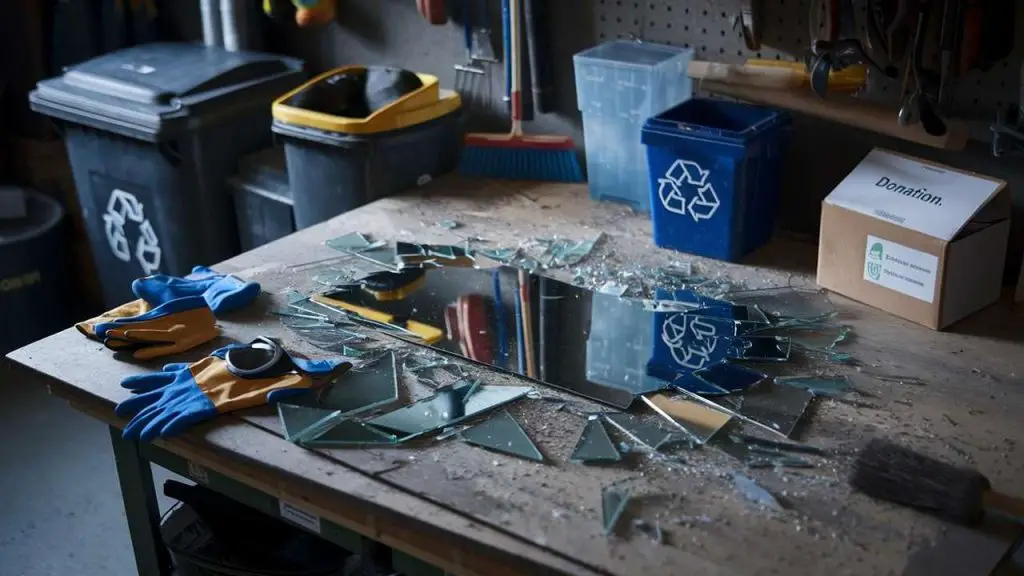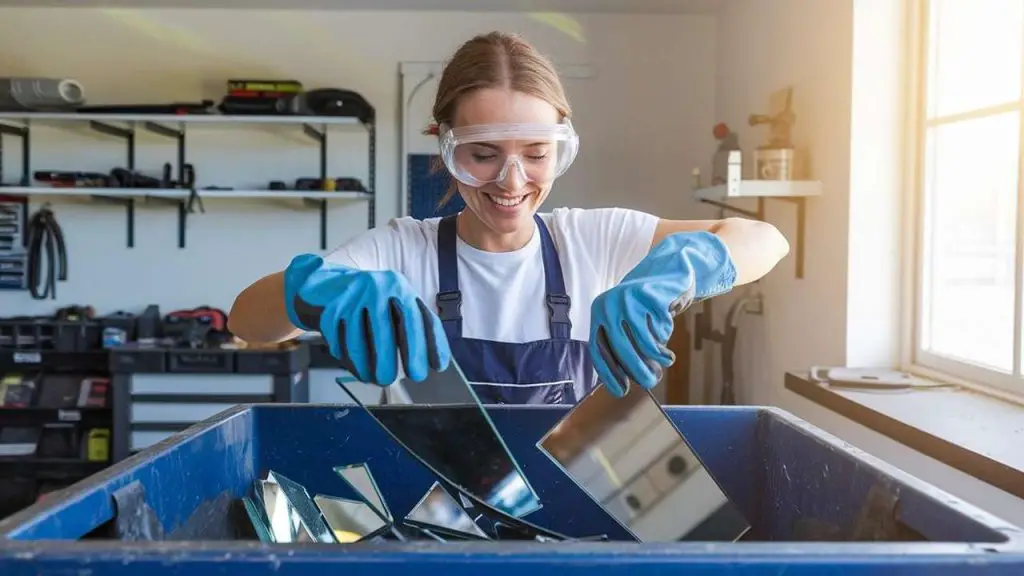Most of us have been faced with this mirror disposal puzzle, either unsure of how to safely and part ways with our reflective friends. Well you’re about to break those mirror disposal fears down to million pieces (safely of course).
It doesn’t matter if you’ve got a tiny vanity mirror or a huge full-length beast but we can help. From crafty upcycling ideas to hiring a professional removal service, here are some surprising tools and ideas to meet this reflective challenge directly.
Safety First: Preparing for Mirror Disposal

A. Prepare safety gear
Looking to dispose of a mirror, your safety remains the ultimate priority. You’ll need to gather important protective gear to keep you safe from injury. Here’s a breakdown of things you need to have on hand:
- Gloves: thick, cut-resistant gloves to protect your hands.
- Protective goggles: To protect your eyes from flinging glass shards
- Long sleeve shirt and pants: To shield your skin
- Closed toed shoes: For glass falling on your feet
- Duct tape: For mending any cracks or loose pieces
(Note that broken mirrors can be surprisingly sharp and dangerous.)
With the use of appropriate gear such as protective gloves and heavy-duty bags, you minimize the chances of getting cut or injured while disposing of potentially hazardous materials.
B. Clear a safe working area
It is essential to create the right workspace before you start working with the mirror. Follow these steps to create a safe environment:
- Find a wide open area with flat ground
- Declutter or remove any stumbling blocks
- Spread a thick tarp or blanket down to catch shards of glass
- Use good lighting so you can see
- Prevent children and pets from accessing the work area
Clearing a dedicated space minimizes the risk of accidents and the cleanup process becomes significantly easier.
C. Enlist a partner for big mirrors
Getting rid of big mirrors can also be somewhat tricky so it’s usually best to have a second set of hands to help you.
Here’s why you might want to enlist some help:
- Enhances stability while lifting and carrying
- Less possibility of dropping and breaking
- Help in the case of emergencies
- Safety measures are a shared responsibility
When working with a partner communicate clearly and coordinate your movements to avoid accidents. Make sure your helper is also equipped with the necessary protective gear.
Now that you’ve prepared for mirror disposal by gathering protective equipment, clearing a safe working area and recruiting help for large mirrors, you’re ready to move on to the next step.
Breaking Down the Mirror

Now that we’ve covered the essential safety preparations, let’s dive into the process of breaking down your mirror for disposal.
1. Methods for controlled breaking
When it comes to breaking your mirror in a controlled manner, you have several options:
- Placing the mirror flat on a table
- Hand cutting with tapping techniques
- Scoring and snapping the glass
Remember to snap the glass immediately after scoring to prevent the score from healing, which could make breaking more difficult.
2. Tools needed for breaking
| Tool | Purpose |
| Hand cutter or wall cutter | For scoring the glass |
| Rubber suction handles | For lifting and manoeuvring large mirrors |
| Pad saw with a hacksaw blade | For cutting through the adhesive |
| Protective gear | To ensure your safety during the process |
3. Containing glass shards
To prevent glass shards from scattering:
- Lay masking tape in an X across the mirror’s face
- Wrap the mirror with towels or bubble wrap
- Use Styrofoam or cushioning foam sheets to cover the front and back
4. Safely Assembling Broken Pieces
Dealing with pieces of a broken mirror:
- Use proper personal protective equipment (PPE) such as eye protection, sturdy gloves, and long trousers
- Lifting heavy glass panes with rubber suction handles
- For large mirrors, work with a team of two to three people
- Cut the adhesive from the exposed vertical edge, then the bottom, then the top edge
- Pull the outermost pane slightly to promote rotation about the inner edge
Following these methods and safety precautions, you’ll be well-prepared to break down your mirror safely. With the mirror now in manageable pieces, we’ll next explore your options for disposing of these mirror fragments responsibly.
Disposal Options for Mirror Fragments

A. Local recycling centers
Unfortunately, mirrors do not recycle well through regular recycling systems due to their reflective metal coating. These coatings often aluminum and other metals contaminate typical glass recycling processes.
But, you should still check at your local recycling centers if any speciality programs allow the recycling of mirror fragments. Other facilities may have designated collection points for coated glass.
While mirrors themselves are not typically recyclable due to their reflective coatings, you might also be worried about recycling other types of glass. To figure it out, take a peek at our guide, Can you Recycle Glass and How to: Things to Know. This resource will help you understand the recycling process for different types of glass and how to dispose of them responsibly.
B. Facilities for managing waste
Most local waste management facilities are trained to deal with shards of mirrors safely and securely. When thinking about leaving broken mirrors at these places:
1. Utilize personal protective equipment (gloves, goggles)
2. Carefully wrap the pieces in newspaper or bubble wrap
3. Put wrapped pieces in a strong cardboard box.
4. Mark the box as “BROKEN GLASS” so it can be handled safely
C. Specialized glass disposal services
If you have a lot of mirror pieces and you’re not comfortable dealing with broken glass, consider professional junk removal services. Companies such as 1-800-GOT-JUNK, Waste Mission, Reconomy run well-equipped glass disposal facilities services. They provide:
- Free estimates
- Safe handling and removal
- Following local guidelines for appropriate disposal
D. Repurposing broken mirror pieces
If you are crafty you can use your mirror pieces for different décor. Here are some ideas:
| Project | Description |
| Picture frames | Create a mosaic border around existing frames |
| Garden Decor | Use fragments to add sparkle to planters or stepping stones |
| Christmas ornaments | Craft unique, reflective tree decorations |
| Jewellery | Design one-of-a-kind pendants or earrings |
Be careful working with pieces of mirror as you do in these projects. Always wear protective gear and work in a well-ventilated area.
Now that we know about these disposal options, let’s explore alternatives to traditional disposal that are eco-friendly.
Eco-Friendly Alternatives to Disposal

1. Donating usable mirrors
If your mirror is still in good condition, consider donating it. You can give it a new home and reduce waste in the process. Here are some options:
- Thrift stores
- Charity organizations
- Local schools or community centers
- Theatre groups for set design
2. Upcycling ideas for old mirrors
Turn your old mirrors into unique decor items. Here are some fun DIY projects to try:
- Chalkboard conversion: Convert a broken mirror frame into a useful chalkboard for your family.
- Rustic transformation: Use stone tiles to give an outdated mirror a fresh, rustic look.
- Jewelry frame: Create a one-of-a-kind mirror frame using vintage jewelry pieces.
- Sports-themed mirror: Repurpose old tennis rackets into a fun, sporty mirror frame.
- Magnetic board: Convert your mirror into a stylish magnetic board for notes and reminders.
| Project | Difficulty | Materials Needed |
| Chalkboard | Easy | Mirror frame, chalkboard paint |
| Rustic frame | Medium | Mirror, stone tiles, adhesive |
| Jewelry Frame | Medium | Mirror, vintage jewelry, strong glue |
| Sports mirror | Easy | Mirror, tennis rackets, paint |
| Magnetic board | Easy | Mirror, magnetic paint or sheet |
3. Selling mirrors online or at yard sales
If DIY isn’t your jam, you can still give your mirror a second chance by selling it. Consider these options:
- Online marketplaces (e.g., Facebook Marketplace, Craigslist)
- Any yard sale (or garage sale) in the area
- Flea markets
- Antique shops (for vintage or unique mirrors)
By choosing one of these eco-friendly alternatives, you’re not only avoiding disposal but also potentially benefiting others or unleashing your creativity.
Legal Considerations
Now that we’ve explored eco-friendly alternatives to mirror disposal, it’s crucial to understand the legal aspects of getting rid of your old or broken mirrors..
1. Local regulations for mirror disposal
When it comes to disposing of mirrors, you need to be aware that local regulations can vary significantly. Here are some key points to consider:
- Mirrors are generally not recyclable due to their reflective coatings which can contaminate regular glass recycling processes.
- Many localities require mirrors to be taken to resource recovery centers rather than placed in regular trash bins, especially for larger mirrors.
- Some areas may have specific guidelines for wrapping and labeling mirror waste before disposal.
To ensure compliance, contact your local waste management services for specific disposal guidelines in your area.
2. Penalties for improper disposal
Most states have penalties for the improper disposal of mirrors. The reference content makes no mention of exact fines and just a few things to bear in mind:
- Placing mirrors in recycling bins is generally prohibited and can result in contamination of recyclable materials.
- Improper disposal may lead to safety hazards, potentially resulting in liability issues.
3. Proper documentation for disposal
In fact, when you want to dispose of mirrors (especially larger ones) proper paperwork may need to be filled out in order to do so.
- Resource recovery centers may require proof of residence or identification.
- Some facilities might charge fees for mirror disposal, so keep receipts for your records.
- If using professional junk removal services, ensure they provide documentation of proper disposal.
| Documentation Type | Purpose |
| Proof of Residence | Required by some facilities |
| Disposal Receipts | Evidence of proper disposal and paid fees |
| Service Invoices | Proof of professional disposal services |
Keep in mind that proper documentation not only simplifies things with local laws, but also gives you peace of mind that your mirrors have been disposed of in a legal and responsible manner.
Following these legal guidelines will help you dispose of your mirrors in a manner that is safe, environmentally friendly, and adheres to the local laws and regulations.
Conclusion

By following the safety precautions outlined in this guide, you can confidently handle mirror disposal without fear of injury or bad luck. Remember to wrap your mirrors securely, whether they’re broken or intact, and consider the various disposal options available to you.

